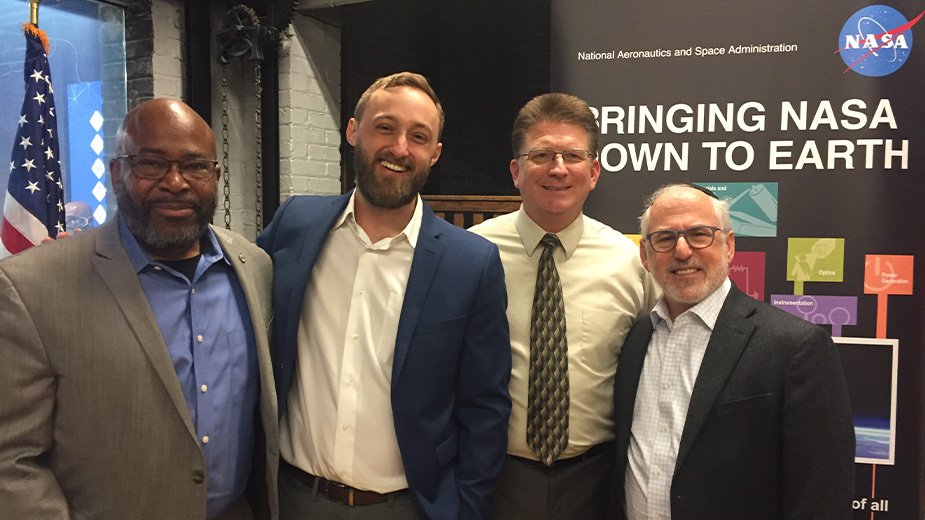NASA Courts Businesses to Use, Develop its Technology
YOUNGSTOWN, Ohio – Petra Power, a Brite Energy Innovators portfolio company based in Warren, is likely one of few companies in the region that credits the National Aeronautics and Space Administration for bringing it to Ohio.
The company has partnered with NASA Glenn Research Center in Cleveland to develop the agency’s solid oxide fuel cell technology for commercial use.
“NASA has been very cognizant, very focused on the commercialization of this technology,” said Aaron Goodman, Petra Power’s CEO.
Goodman, who holds a Ph.D. in mechanical and aerospace engineering from Princeton University, said he and co-founder Phillip Clift had entered a competition hosted by a third party in conjunction with NASA several years ago.
“We were fortunate to put together a compelling enough business and commercialization plan to be able to receive the license for our patent,” Goodman said. “From there, I have to give all the credit to NASA for helping us grow that relationship. NASA and Brite kind of teamed up on bringing us to Ohio.”
Goodman declined to be specific about the company’s work. But he said that solid oxide fuel cells could play a significant role as an energy source for emergency backup stations and as auxiliary power for ground and air transportation. “I think the future does encompass that entire energy space,” he said.
The partnership is one of many that NASA Glenn hopes to cultivate with the private sector across northeastern Ohio to bring its technology to market, said Tom Doehne, a specialist with the Office of Technology Incubation and Innovation at NASA Glenn.
“Most people think that it’s very difficult to work with a government agency,” Doehne said. “We try to make it very easy for people to reach out and understand our programs.”
Doehne was the featured speaker at a technology transfer informational seminar held at America Makes on Thursday. The APEX Accelerator at Youngstown State University, Brite Energy, the Youngstown Business Incubator and America Makes hosted the event.
“We have lots of different technologies that we’re looking to commercialize,” Doehne said.
Countless common products have spun off from NASA technology, space exploration and research, Doehne said. These include memory foam, firefighter gear, GPS technology, cellphone image technology, satellite and space communication, invisible braces and wireless technology, Doehne said.
Even baby formula and the Dust Buster vacuum had their origins at NASA, he added.
The space agency has also pioneered work in advanced materials and electrical systems that could be used by manufacturers and applied throughout a broad range of industries.
“People wonder what we actually create out of NASA’s technologies,” Doehne said. “There are things you use in your day-to-day life that you probably don’t know came from NASA’s technologies.”
Doehne said NASA provides funding opportunities through its traditional Small Business Innovation Research and Small Business Technology Transfer programs. Both initiatives are designed to help companies leverage NASA-developed technology in the private sector.
Small businesses – one with fewer than 500 employees – can participate in the SBIR program as a stand-alone entity. To qualify for STTR funding, however, the business would also need to partner with a nonprofit research institution.
Doehne said the objective is to use NASA Glenn to leverage a stronger economy across northeastern Ohio. However, many companies that are awarded early funding for its SBIR program, for example, don’t often proceed to Phase II and Phase III funding.
This led to the adoption of a new program, SBIR Ignite, which focuses on funding entrepreneurs and start-up companies that aim to take new technology to full commercialization through the entire three phases, Doehne said.
NASA’s technology transfer initiatives involve building partnerships across the country with universities and organizations that are looking to support entrepreneurs and start-ups using NASA technology, Doehne said.
One program, Technology Transfer University, is specifically designed to engage students, he said. “We ask them to utilize our technology portfolio in their entrepreneurial classes,” he said. Throughout the course, students would learn about licensing and commercial opportunities with NASA.
Should a company’s needs fit the mission and the technology that NASA has developed, they could license this technology and access the agency’s patent portfolio, Doehne said.
A research license, for example, enables a company to work with this technology and its inventor to further explore how it could integrate into the commercial market, Doehne said. “It gives you a runway to work with the technology and get some real review of what your product is,” he said.
The license is no cost to start-ups and universities, but is $2,500 for all other applicants, he said.
A government-use license is awarded to organizations doing research and helping NASA in its mission, Doehne said. This license cannot be used for commercial purposes, only within the government.
The commercial license, however, allows a private entity to secure the rights to make and sell products based on NASA technology, Doehne said. These licenses are both nonexclusive – that is, it is open to any company to use in the same field – and partially exclusive, which allows a company to enter a specific market, such as metals or transportation.
Jon Loveland, procurement consultant for The APEX Accelerator at YSU, said Thursday’s event was intended to make local manufacturers and businesses aware of the commercial opportunities with NASA.
“We’ve collaborated with their office of technology transfer for a number of years,” Loveland said. However, this is the first NASA event that incorporates resources from APEX, Brite, YBI and America Makes.
“The whole goal is to get people to use our technology,” Doehne said. “We’re not out here to make a lot of money on these technologies. Taxpayers’ money has supported and paid for the research, and all we’re trying to do is get those technologies back out there so industry can have an impact.”
Pictured at top: James O. Wilson of the U.S. Patent and Trademark Office; Aaron Goodman, CEO of Petra Power; Tom Doehne, specialist at NASA Glenn Research Center’s technology transfer office; and Harvey Schabes, NASA Glenn chief, technology transfer office.
Copyright 2024 The Business Journal, Youngstown, Ohio.



